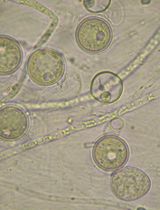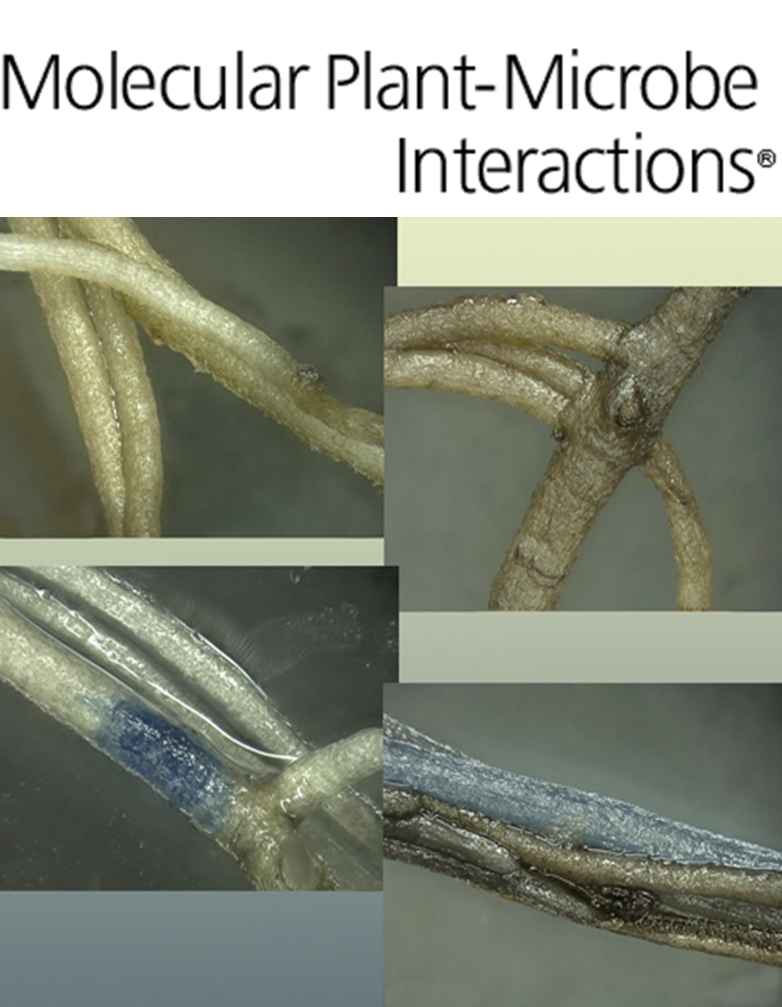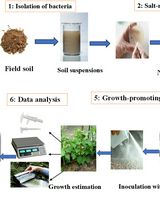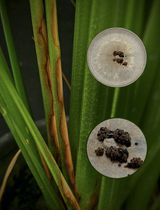- EN - English
- CN - 中文
Establishment of a Fusarium graminearum Infection Model in Arabidopsis thaliana Leaves and Floral Tissues
建立拟南芥叶片和花组织的禾谷镰刀菌感染模型
发布: 2016年07月20日第6卷第14期 DOI: 10.21769/BioProtoc.1877 浏览次数: 13172
评审: Arsalan DaudiSara Posé Shweta Kalve

相关实验方案

微生物提取物对卵菌辣椒疫霉菌和猝倒病疫霉的体外筛选
Mónica Trigal Martínez [...] María Ángeles Vinuesa Navarro
2025年09月20日 556 阅读
Abstract
Fusarium graminearum (Fg) is the causal agent of Fusarium head blight disease of wheat (Triticum aestivum), oats (Avena sativa) and barley (Hordeum vulgare), which targets the floral tissues and thereby adversely impacts grain yield and quality. Mycotoxins produced by F. graminearum further limit the consumability of infected grain. In the laboratory, F. graminearum also has the ability to colonize both leaves and inflorescence tissues of Arabidopsis thaliana. The interaction between A. thaliana and F. graminearum makes available a large array of genetic and molecular tools to study the interaction between plants and F. graminearum to elucidate plant genes and pathways that contribute to resistance, as well as study how the fungus targets plant genes and mechanisms to promote disease. The methods described below allow for efficient infection of Arabidopsis leaves and inflorescence, and evaluation of disease progress and fungal growth. Disease spread in Arabidopsis can be readily monitored by the visual observations of chlorosis of leaf tissue and disease phenotype of inflorescence tissue including fungal mass on surface of the inflorescence tissue. Fungal growth can be further monitored by measuring the relative amount of Fg DNA in the host tissue by polymerase chain reaction (PCR) and quantitative real-time PCR (qPCR).
Background
Materials and Reagents
- PCR tubes (Fisher Scientific, catalog number: 14222 262 )
- Petri dishes (100 x 15 mm) (Fisher Scientific, catalog number: FB0875713 )
- 50 ml plastic screw-capped tubes (Midsci, catalog number: C50B )
- Pipette tips (sterile) (Midsci, catalog number: AVR-1, AVR-4 and AVR-11 )
- 1.7 ml microfuge tubes (sterile) (Catalog number: AVSS1700 )
- Cheesecloth from a local craft store or Miracloth (EMD Millipore, catalog number: 475855-1R )
- Culture tube
- 1 ml needle-less syringe (Tuberculin syringe) (Becton Dickinson, catalog number: 309659 )
- Funnel
- 1 L glass conical flask (Pyrex brand)
- Tweezers
- Hemocytometer
- Camel hair brush
- Sharpie or comparable water-proof marker
- Disposable gloves
- Kimwipes, tissue paper or paper towels
- Face shield (Fisher Scientific, catalog number: 18-999-4542 )
- Kord brand 3.5 inch square pots with bottom holes (Hummert International, catalog number: 12-1350-1 )
- T.O. Plastics Standard Flats 1020 tray with bottom holes (Hummert International, catalog number: 11-3000-1 )
- T.O. Plastics Standard Flats 1020 tray without holes (Hummert International, catalog number: 11-3050-1 )
- DOM1020 plastic dome to fit 1020 flats (Hummert International, catalog number: 11-3360-1 )
- Transparent plastic bags (Glad 13 gallon Recycling Drawstring Clear Trash bag)
- Fusarium graminearum isolate Z-3639 (Bowden and Leslie, 1999)
- Arabidopsis thaliana seeds (Accession Columbia, Nössen, and Wassilewskija)
- Silwet L-77 (Lehle seeds, catalog number: VIS-30 )
- Potato Dextrose Broth (Becton Dickinson, catalog number: 254920 )
- Yeast extract (Becton Dickinson, catalog number: 212750 )
- BD Difco Agar (Becton Dickinson, catalog number: 214530 )
- Ammonium Nitrate (Fisher Scientific, catalog number: A676 )
- Potassium chloride (Fisher Scientific, catalog number: P217 )
- Magnesium sulfate heptahydrate (Fisher Scientific, catalog number: M63 )
- Sodium chloride (Fisher Scientific, catalog number: BP358-1 )
- Tris-Base (Fisher Scientific, catalog number: BP152 )
- Ethylenediaminetetraacetic acid, disodium salt, Dihydrate (Fisher Scientific, catalog number: S311 )
- Sodium dodecyl sulfate (Fisher Scientific, catalog number: BP166 )
- Carboxymethyl cellulose, CMC (Sigma-Aldrich, catalog number: C5678 )
- Sterile deionized water (dH2O)
- Sterile double distilled water (ddH2O)
- Phenol (Fisher Scientific, catalog number: BP226500 )
- Chloroform (Fisher Scientific, catalog number: C607-4 )
- Isopropanol (Fisher Scientific, catalog number: A451SK-4 )
- Ethanol (Fisher Scientific, catalog number: A995-4 )
- Primers (Listed below in Table 1)
- dNTPs (Sigma-Aldrich, catalog number: DNTP100A-1KT )
- Polymerase for PCR (Fisher Scientific, catalog number: FB-6000-10 )
- iTaq Univeral SYBR Green Supermix (Bio-Rad, catalog number: 1725122 )
- Agarose (Fisher Scientific, catalog number: BP1356 )
- Soil mix (Fafard, catalog number: Fafard Growing Mix 2/C-2 )
- Peters 20:20:20 General Purpose fertilizer (Hummert International; catalog number: 07-5400-1 )
- F. graminearum macroconidia suspension (see Procedure)
- F. graminearum mycelial fragments (see Procedure)
- Potato Dextrose Agar-Half strength (½ PDA) (see Recipes)
- Carboxymethyl Cellulose (CMC) media (see Recipes)
- Arabidopsis DNA extraction buffer (see Recipes)
- Tris-equilibrated phenol-chloroform (see Recipes)
- Spray spore suspension (see Recipes)
Equipment
- Hand-held atomizer
- Micropipettes (P20, P100 and P1000)
- Standard Lab Incubator for cultivating fungus (Fisher Scientific, Fisher ScientificTM IsotempTM)
- Plant growth chamber for cultivating Arabidopsis (Percival scientific, model: AR-66L2 )
- Thermal cycler (Techne, model: 3PrimeX )
- Real-time PCR system (Illumina, EcoTM, catalog number: EC-101-1001 )
Note: This product has been discontinued by the manufacturer. - Compound microscope (Leica, model: DM2000 )
- Tabletop centrifuge (Beckman)
- Microfuge (Fisher Scientific, Fisher ScientificTM accuSpinTM, model: Micro 17/Micro 17R )
- Vortex-Genie 2 (Scientific Industries, catalog number: SI-0236 )
- Basic power supply gel electrophoresis powerpack, trays and combs, (Bio-Rad, PowerPacTM, catalog number: 1645050 )
- Gel electrophoresis system (Bio-Rad, catalog number: 1704405 )
Software
- Variance (ANOVA) (P < 0.05) (SAS Institute Inc, SAS v5.1)
Procedure
文章信息
版权信息
© 2016 The Authors; exclusive licensee Bio-protocol LLC.
如何引用
Nalam, V., Sarowar, S. and Shah, J. (2016). Establishment of a Fusarium graminearum Infection Model in Arabidopsis thaliana Leaves and Floral Tissues. Bio-protocol 6(14): e1877. DOI: 10.21769/BioProtoc.1877.
分类
植物科学 > 植物免疫 > 病害生物测定
植物科学 > 植物免疫 > 宿主-细菌相互作用
微生物学 > 微生物-宿主相互作用 > 真菌
您对这篇实验方法有问题吗?
在此处发布您的问题,我们将邀请本文作者来回答。同时,我们会将您的问题发布到Bio-protocol Exchange,以便寻求社区成员的帮助。
提问指南
+ 问题描述
写下详细的问题描述,包括所有有助于他人回答您问题的信息(例如实验过程、条件和相关图像等)。
Share
Bluesky
X
Copy link













